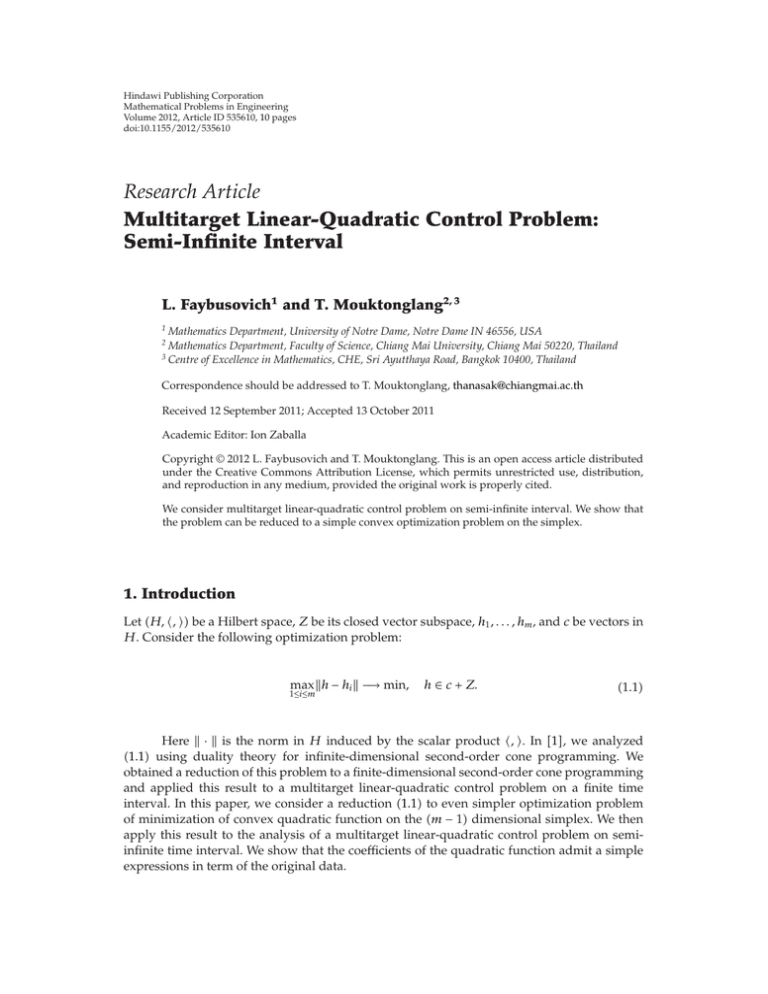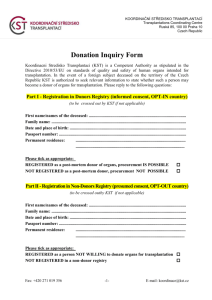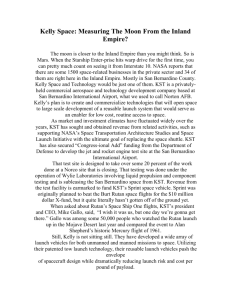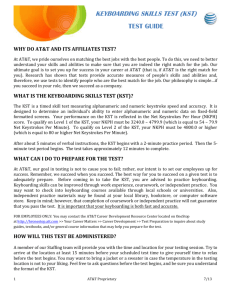Document 10953394
advertisement

Hindawi Publishing Corporation
Mathematical Problems in Engineering
Volume 2012, Article ID 535610, 10 pages
doi:10.1155/2012/535610
Research Article
Multitarget Linear-Quadratic Control Problem:
Semi-Infinite Interval
L. Faybusovich1 and T. Mouktonglang2, 3
1
Mathematics Department, University of Notre Dame, Notre Dame IN 46556, USA
Mathematics Department, Faculty of Science, Chiang Mai University, Chiang Mai 50220, Thailand
3
Centre of Excellence in Mathematics, CHE, Sri Ayutthaya Road, Bangkok 10400, Thailand
2
Correspondence should be addressed to T. Mouktonglang, thanasak@chiangmai.ac.th
Received 12 September 2011; Accepted 13 October 2011
Academic Editor: Ion Zaballa
Copyright q 2012 L. Faybusovich and T. Mouktonglang. This is an open access article distributed
under the Creative Commons Attribution License, which permits unrestricted use, distribution,
and reproduction in any medium, provided the original work is properly cited.
We consider multitarget linear-quadratic control problem on semi-infinite interval. We show that
the problem can be reduced to a simple convex optimization problem on the simplex.
1. Introduction
Let H, , be a Hilbert space, Z be its closed vector subspace, h1 , . . . , hm , and c be vectors in
H. Consider the following optimization problem:
max h − hi −→ min,
1≤i≤m
h ∈ c Z.
1.1
Here · is the norm in H induced by the scalar product , . In 1, we analyzed
1.1 using duality theory for infinite-dimensional second-order cone programming. We
obtained a reduction of this problem to a finite-dimensional second-order cone programming
and applied this result to a multitarget linear-quadratic control problem on a finite time
interval. In this paper, we consider a reduction 1.1 to even simpler optimization problem
of minimization of convex quadratic function on the m − 1 dimensional simplex. We then
apply this result to the analysis of a multitarget linear-quadratic control problem on semiinfinite time interval. We show that the coefficients of the quadratic function admit a simple
expressions in term of the original data.
2
Mathematical Problems in Engineering
2. Reduction to a Simple Quadratic Programming Problem
Let fi h h − hi 2 , i 1, 2, . . . , m. It is obvious that 1.1 is equivalent to the following
optimization problem:
z −→ min,
fi h ≤ z,
i 1, 2, . . . , m , h ∈ c Z.
2.1
Consider the Lagrange function
Lλ1 , . . . , λm , h, z z m
λi fi h − z
i1
z 1−
m
λi
i1
m
2.2
λi fi h.
i1
Notice that despite the fact that our original problem is infinite dimensional, the usual
KKT theorem holds true see e.g., 2, page 72. It is also clear that Slater conditions are
satisfied. Hence, optimality condition for 2.1 takes the form
λi fi h − z 0, i 0, 1, 2, . . . , m,
λi ≥ 0,
m
∂L
0,
λi ∇fi h ∈ Z⊥ ,
∂z
i1
2.3
where ∇fi h 2h − hi , i 1, 2, . . . , m, Z⊥ is the orthogonal complement of Z in H.
Conditions 2.3 lead to
m
λi 1,
λi ≥ 0, i 1, 2, . . . , m,
i0
πZ h m
2.4
λi πZ hi .
i1
Here πZ : H → Z is the orthogonal projection. Let us form the Lagrange dual of 2.1.
Consider
ϕλ1 , λ2 , . . . , λm min{Lλ1 , . . . , λm , h, z : h ∈ c Z, z ∈ Z}.
2.5
Using 2.4, we obtain that
ϕλ1 , λ2 , . . . , λm m
i1
λi fi hλ1 , . . . , λm ,
2.6
Mathematical Problems in Engineering
3
where
hλ1 , . . . , λm πZ⊥ c m
λi πZ hi .
2.7
i1
Notice that for any h ∈ c Z, π Z⊥ h πZ⊥ c. Here πZ⊥ : H → Z⊥ is the orthogonal
projection of H onto orthogonal complement Z⊥ of Z. To further simplify 2.6, introduce the
notation
hλ m
λi hi .
2.8
i1
Then
2
fj hλ1 , . . . , λm πZ hλ − hj πZ⊥ c − hj 2 2
πZ hλ − πZ hj πZ⊥ c − hj 2
πZ hλ2 πZ hj − 2 πZ hλ, π Z hj
2
πZ⊥ c − hj .
2.9
Hence, according to 2.6, we have the following:
ϕλ1 , . . . , λm πZ hλ2 m
2
λj πZ hj j1
m
2
− 2πZ hλ, π Z hλ λj πZ⊥ c − hj .
2.10
j1
We, hence, arrive at the following expression of ϕ:
2
m
m
2
2
⊥
πZ hj
λi hi λj
πZ c − hj .
ϕλ1 , . . . , λm −πZ
i1
j1
2.11
We can simplify 2.11 somewhat. Notice that
πZ⊥ c − hj 2 πZ⊥ c2 πZ⊥ hj 2 − 2 πZ⊥ c, π Z⊥ hj .
2.12
4
Mathematical Problems in Engineering
Consequently,
ϕλ1 , . . . , λm −πZ hλ2 m
2
λj hj j1
− 2πZ⊥ c, π Z⊥ hλ πZ⊥ c2
−hλ2 πZ⊥ hλ − c2 2.13
m
2
λj hj .
j1
Here,
hλ m
λi hi .
2.14
i1
Hence, the Lagrange dual to 2.1 takes the following form:
ϕλ1 , . . . , λm −→ max,
m
i1
λi 1,
λi ≥ 0, i 1, 2, . . . , m.
2.15
If λ∗1 , . . . , λ∗m is an optimal solution to 2.15, we can recover the optimal solution of
the original problem using the relation 2.7, and ϕλ∗1 , . . . , λ∗m gives the optimal value for the
original problem 1.1.
3. Linear-Quadratic Case
Denoted by Ln2 0, ∞, the vector space of square integrable functions f : 0, ∞ → Rn . Let
H Ln2 0, ∞ × Lm
2 0, ∞, and
Z
α, β ∈ H : α is absolutely continuous on 0, ∞, α̇ Aα Bβ, α0 0 .
3.1
Here A respectively B is an n by n respectively n by m matrix. Observe that
α1 , β1 , α2 , β2 ∞
α1 tT α2 t β1 tT β2 t dt,
0
αi , βi ∈ H,
3.2
i 1, 2.
In this setting, the problem 1.1 admits a natural interpretation as a linear-quadratic
multitarget control problem. An interesting solution for this problem for m 2 is described
in 3. In our approach, we need an explicit computation of the coefficients of the objective
function 2.13 which in turn requires an explicit description of orthogonal projection πZ .
Such a description has been found in 4. We briefly describe it here.
Mathematical Problems in Engineering
5
Theorem 3.1. Let C be an antistable n by n matrix (i.e., real parts of all eigenvalues of C are positive).
Consider the following system of linear differential equations:
ẋ Cx f,
3.3
where f ∈ Ln2 0, ∞. Then there exists a unique solution Lf of 3.3 belonging to Ln2 0, ∞.
Moreover, the map L : Ln2 0, ∞ → Ln2 0, ∞ is linear and bounded. Explicitly,
L f t −
∞
e−Cτ ft τdτ.
3.4
KBBT K AT K KA − I 0.
3.5
0
For the proof, see 4.
Consider the algebraic Riccati equation
We assume that 3.5 has a real symmetric solution Kst such that the matrix
3.6
F A BBT Kst
is stable i.e., real parts of all eigenvalues of F are negative. Notice that such a solution exists
if and only if the pair A, B is stabilizable. See, for example, 5.
Theorem 3.2. We have the following:
Z⊥ ṗ AT p, BT p ; p ∈ Ln2 0, ∞, p is absolutely continuous, ṗ ∈ Ln2 0, ∞ .
3.7
Given that ψ, ϕ ∈ H, we have
ψ x − ṗ AT p ,
3.8
ϕ u − BT p,
3.9
where x is the solution of the differential equation
ẋ A BBT Kst x BBT ρ Bϕ,
x0 0,
3.10
u BT Kst x BT ρ ϕ,
3.11
p Kst x ρ,
3.12
and ρ is a unique solution to the differential equation
T
ρ̇ − A BBT Kst ρ − Kst Bϕ − ψ
3.13
6
Mathematical Problems in Engineering
belonging to Ln2 0, ∞.
In particular, x, u ∈ Z, −ṗ AT p, BT p ∈ Z⊥ , and consequently Z is a closed subspace in
H with
π Z⊥ ψ, ϕ − ṗ AT p, BT p .
πZ ψ, ϕ x, u,
3.14
Remark 3.3. The required solution ρ exists and unique by Theorem 3.1, since the matrix −A BBT Kst is antistable.
Sketch of the Proof
Let p ∈ Ln2 0, ∞ be absolutely continuous and such that ṗ ∈ Ln2 0, ∞. Suppose that x, u ∈ Z.
Then
x, u, ṗ A p, B p
T
T
∞
xT ṗ xT AT p uBT p dt
0
∞
xT ṗ Ax BuT p dt
0
∞
xT ṗ ẋT p dt
3.15
0
∞
0
d T x p dt
dt
lim xT τpτ − x0T p0.
τ →∞
But xτ, pτ → 0, as τ → ∞ see e.g., 4 for details and x0 0. Hence,
0.
x, u, ṗ AT p, BT p
3.16
Let us now show that the decomposition 3.5 and 3.9 takes place for an arbitrary
ψ, ϕ ∈ H. Indeed, using 3.12,
ṗ Kst ẋ ρ̇.
3.17
Hence by 3.10 and 3.13,
T
ṗ Kst A BBT Kst x Kst BBT ρ Kst Bϕ − A BBT Kst ρ − Kst Bϕ − ψ.
3.18
Mathematical Problems in Engineering
7
Combining all terms with x and all terms with ρ in two separate groups, we obtain that
ṗ AT p ṗ AT Kst x AT ρ
Kst A Kst BBT Kst AT Kst x
3.19
Kst BBT − AT − Kst BBT AT ρ − ψ.
Using now the fact that Kst satisfies 3.5, we obtain that
ṗ AT p x − ψ
3.20
which is 3.8. Using 3.11 and 3.12, we obtain that
u − BT p BT Kst x BT ρ ϕ − BT Kst x − BT ρ
ϕ,
3.21
which is 3.9. Finally, it is clear that for x and u defined by 3.11 and 3.12, we have
ẋ Ax Bu
3.22
and consequently x, u ∈ Z. This completes the proof of Theorem 3.2.
Looking at 2.13, we see that the evaluation of coefficients of the quadratic function
requires the knowledge of expressions of the type πZ⊥ h2 , where h ∈ H.
Theorem 3.4. Let h ψ, ϕ ∈ H, and ρ ∈ Ln2 0, ∞ is the function entering the decomposition
3.8 and 3.9 and described in 3.13. Then
2
πZ h2 BT ρ ϕ ,
3.23
2
πZ⊥ h2 h2 − BT ρ ϕ .
3.24
Proof. Let y, ν ∈ Z. Let, further,
T ν − BT Kst y − BT ρ − ϕ .
Δ y, ν ν − BT Kst y − BT ρ − ϕ
3.25
Here for simplicity of notations, we suppressed the dependence on t. Then
Δ y, ν Δ1 Δ2 Δ3 ,
3.26
8
Mathematical Problems in Engineering
where
T T
T T
B Kst y ρ .
Δ1 ν − ϕ ν − ϕ , Δ2 Kst y ρ BBT Kst y ρ , and Δ3 −2 ν − ϕ
3.27
Since y, ν ∈ Z, we have
ẏ Ay Bν,
y0 0.
3.28
Hence,
Δ2 yT Kst BBT Kst y ρT BBT ρ 2ρT BBT Kst y,
T Δ3 −2 Bν − Bϕ Kst y ρ
T −2 ẏ − Ay − Bϕ Kst y ρ
T
−2ẏKst y yT AT Kst Kst A y 2 Bϕ Kst y
3.29
T
T
− 2ẏT ρ 2 Ay ρ 2 Bϕ ρ.
Notice that ẏT ρ yT ρ̇ d/dtyT ρ. Hence,
T Δ y, ν ν − ϕ ν − ϕ yT Kst BBT Kst AT Kst Kst A y
T BT ρ
2yT ρ̇ Kst Bϕ Kst BBT ρ AT ρ BT ρ
3.30
d
d
yT ρ −
yT Kst y .
2ϕT BT ρ −
dt
dt
Using the fact that Kst is a solution to 3.5 and 3.13, we obtain that
T T BT ρ ϕ
Δ y, ν ν − ϕ ν − ϕ yT y − 2yT ψ BT ρ ϕ
d T d T
y ρ −
y Kst y
dt
dt
T T T BT ρ ϕ
y − ψ BT ρ ϕ
ν−ϕ ν−ϕ y−ψ
− ϕT ϕ −
− ϕT ϕ − ψ T ψ −
3.31
d T d T
y ρ −
y Kst y .
dt
dt
Integrating 3.31 from 0 to ∞ and using the fact that y0 0, yt, ρt → 0 as t → ∞,
we obtain that
∞
2
2 2 Δ y, ν dt y − ψ, ν − ϕ − ψ, ϕ BT ρ ϕ .
3.32
0
Mathematical Problems in Engineering
9
Notice that Δy, ν ≥ 0 and Δy, ν 0 provided y, ν πZ ψ, ϕ. See 3.11. Consequently,
3.32 implies that
2
ψ, ϕ 2 BT ρ ϕ πZ⊥ ψ, ϕ 2 .
3.33
2
πZ ψ, ϕ 2 BT ρ ϕ .
3.34
Hence,
This completes the proof of Theorem 3.4.
We can now easily compute the coefficients of the objective function 2.11. Assuming
n
m
that hi ψi , ϕi ∈ Ln2 0, ∞ × Lm
2 0, ∞, i 1, 2, . . . , m, c α, β ∈ L2 0, ∞ × L2 0, ∞ and
noticing that by Theorem 3.4
πZ hλ − c2 ∞ T BT ρλ ϕλ BT ρλ ϕλ dt,
3.35
0
where ρλ is the solution of the differential equation
T
d
ρλ − A BBT Kst ρλ − Kst B ϕλ − ψλ ,
dt
3.36
belonging to Ln2 0, ∞ and
ϕλ m
λi ϕi − β ,
ψλ i1
m
λi ψi − α .
3.37
i1
Consequently,
ρλ m
λi ρi − ρc ,
3.38
i1
where ρi and ρc are Ln2 0, ∞ solutions of differential equations
ρ̇i − A BBT Kst ρi − Kst Bϕi − ψi ,
i 1, 2, . . . , m,
ρ̇c − A BBT Kst ρc − Kst Bβ − α,
3.39
respectively.
Hence,
2
πZ hλ − c ∞
0
ΓλT Γλdt,
3.40
10
Mathematical Problems in Engineering
where
Γλ m
λi BT ρi − ρc ϕi − β ,
3.41
i1
which allows us to easily express the objective function 2.13 in terms of integrals of ρi and
ρc .
4. Concluding Remarks
In this paper, we have shown that multitarget linear-quadratic control problem on semiinfinite interval can be reduced to solving a simple convex optimization on the simplex.
The reduction involves solving one standard algebraic Riccati equation and m 1 linear
differential equations, where m is the number of targets. Notice that our results can be easily
extended to discrete-time systems.
Acknowledgments
The research of L. Faybusovich was partially supported by NSF Grant DMS07-12809.
The research of T. Mouktonglang was partially supported by the Commission on Higher
Education and Thailand Research Fund under Grant MRG5080192.
References
1 L. Faybusovich and T. Mouktonglang, “Multi-target linear-quadratic control problem and secondorder cone programming,” Systems & Control Letters, vol. 52, no. 1, pp. 17–23, 2004.
2 G. G. Magaril-Il’yaev and V. M. Tikhomirov, Convex Analysis: Theory and Applications, vol. 222 of Translations of Mathematical Monographs, American Mathematical Society, Providence, RI, USA, 2003.
3 A. S. Matveev and V. A. Yakubovich, Optimal Control Systems, Petersburg University, St. Petersburg,
Russia, 2003.
4 L. Faybusovich and T. Mouktonglang, “Linear-quadratic control problem with a linear term on semiinfinite interval: theory and applications,” Tech. Rep., University of Notre Dame, December 2003.
5 L. E. Faı̆busovich, “Algebraic Riccati equation and symplectic algebra,” International Journal of Control,
vol. 43, no. 3, pp. 781–792, 1986.
Advances in
Operations Research
Hindawi Publishing Corporation
http://www.hindawi.com
Volume 2014
Advances in
Decision Sciences
Hindawi Publishing Corporation
http://www.hindawi.com
Volume 2014
Mathematical Problems
in Engineering
Hindawi Publishing Corporation
http://www.hindawi.com
Volume 2014
Journal of
Algebra
Hindawi Publishing Corporation
http://www.hindawi.com
Probability and Statistics
Volume 2014
The Scientific
World Journal
Hindawi Publishing Corporation
http://www.hindawi.com
Hindawi Publishing Corporation
http://www.hindawi.com
Volume 2014
International Journal of
Differential Equations
Hindawi Publishing Corporation
http://www.hindawi.com
Volume 2014
Volume 2014
Submit your manuscripts at
http://www.hindawi.com
International Journal of
Advances in
Combinatorics
Hindawi Publishing Corporation
http://www.hindawi.com
Mathematical Physics
Hindawi Publishing Corporation
http://www.hindawi.com
Volume 2014
Journal of
Complex Analysis
Hindawi Publishing Corporation
http://www.hindawi.com
Volume 2014
International
Journal of
Mathematics and
Mathematical
Sciences
Journal of
Hindawi Publishing Corporation
http://www.hindawi.com
Stochastic Analysis
Abstract and
Applied Analysis
Hindawi Publishing Corporation
http://www.hindawi.com
Hindawi Publishing Corporation
http://www.hindawi.com
International Journal of
Mathematics
Volume 2014
Volume 2014
Discrete Dynamics in
Nature and Society
Volume 2014
Volume 2014
Journal of
Journal of
Discrete Mathematics
Journal of
Volume 2014
Hindawi Publishing Corporation
http://www.hindawi.com
Applied Mathematics
Journal of
Function Spaces
Hindawi Publishing Corporation
http://www.hindawi.com
Volume 2014
Hindawi Publishing Corporation
http://www.hindawi.com
Volume 2014
Hindawi Publishing Corporation
http://www.hindawi.com
Volume 2014
Optimization
Hindawi Publishing Corporation
http://www.hindawi.com
Volume 2014
Hindawi Publishing Corporation
http://www.hindawi.com
Volume 2014






